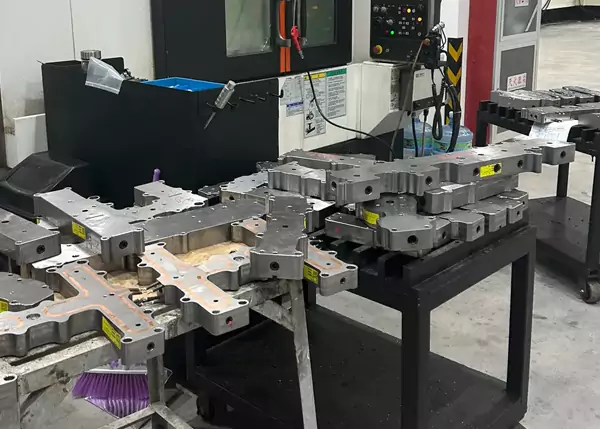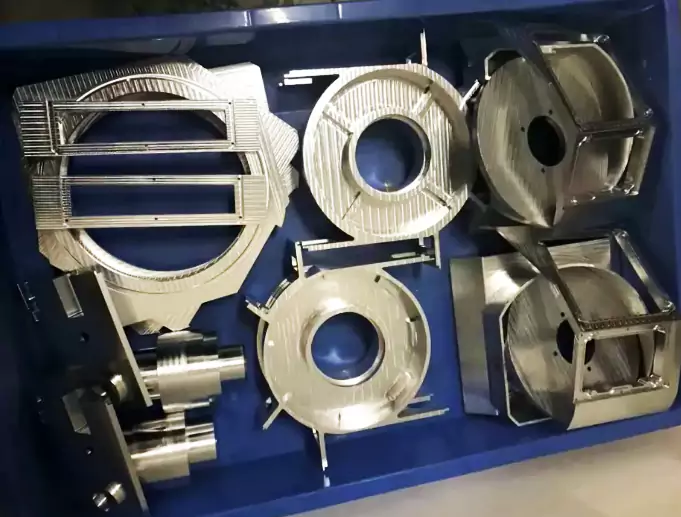How to process multi-faceted parts with CNC milling machine?
CNC milling machine processing technology has a very wide range of applications and can be used in various industrial fields, such as aviation, automobile, machinery, electronics, medicine, and so on. In these fields, it is often necessary to process high-precision, complex-shaped parts, and CNC milling machine processing can be controlled by the program to achieve high-precision, high-efficiency, high-automation processing of these parts to meet the needs of the modern manufacturing industry.

Multi-faceted parts are very common parts in CNC machining, usually, the process of machining needs to be cut and processed several times, such as mechanical equipment shells, lids, templates, and so on.
According to the difficulty and complexity of machining, multi-faceted parts can be divided into simple multi-faceted parts and complex multi-faceted parts. Simple multi-faceted parts refer to parts with two or three machining surfaces, such as lids and bases. The processing of this type of parts is relatively simple, the machining process only requires some basic cutting, and machining operations can be completed.

Complex multi-faceted parts refer to parts with more than one machining surface, such as templates, machine housings, and so on. The machining of such parts is more difficult, requiring multiple cutting and machining operations, and the need to choose the appropriate process and machining parameters to ensure the accuracy and quality of machining.
How to machine multi-faceted parts efficiently and with high quality?
This not only involves the key technology and parameter determination but also has a lot to do with the tooling and programming. This is a process that needs to be considered and planned in many aspects in advance.
Key technologies
Reasonable workpiece clamping can ensure the positional accuracy and stability of the parts during machining, thus improving machining quality and efficiency. When machining multi-faceted parts, it is necessary to select the appropriate workpiece fixture and carry out the correct clamping method to ensure that the parts will not be displaced or deformed during the machining process. Common workpiece clamping techniques are shown in Table 1.

Tool selection and determination of cutting parameters
CNC milling machine processing multi-face parts, tool selection and cutting parameters are very important to determine, which is directly related to the processing efficiency and processing quality.
First of all, according to the geometric characteristics and requirements of the machined parts, it is necessary to choose the appropriate tool type and specification. For example, for parts with different shapes and surface features, it may be necessary to use different types of tools such as plane milling cutter, ball end milling cutter, end milling cutter, T-shaped cutter, etc. for processing.
Secondly, it is necessary to determine the appropriate cutting parameters according to the nature of the processed material and processing requirements, including cutting speed, feed rate, tool diameter, depth of cut, etc.. Reasonable cutting parameters can effectively improve machining efficiency and quality but need to be adjusted and optimized appropriately according to the characteristics of the tool and workpiece in the actual machining process.
In addition, the selection of tools and the determination of cutting parameters are also affected by the performance of the machine tool. For example, parameters such as machining speed and feed rate need to be determined according to the spindle speed of the CNC milling machine, spindle power, feed system speed and accuracy, and other factors. Comprehensive consideration of the above factors, select the most appropriate tool and cutting parameters to improve machining efficiency and quality while reducing the wear and failure of the machine tool.
CNC programming technology
CNC programming is one of the key technologies for CNC milling machine processing of multi-faceted parts, and its correctness and efficiency directly affect the processing quality and efficiency. CNC programming requires mastery of the basic principles of CNC machining, mathematical knowledge, computer knowledge and programming language, and other aspects of knowledge, and at the same time need to have a certain amount of practical experience in CNC machining. In general, CNC programming can be used to manually program, and CAM software to automatically generate the program in two ways.
Manual programming refers to manually entering the CNC machining program to control the CNC milling machine for processing. Manual programming requires mastery of the basic principles of CNC machining and programming language. In manual programming, according to the geometric characteristics of the parts and processing requirements, the preparation of appropriate machining programs to ensure the accuracy and quality of parts processing.
CAM software automatically generates the program is a kind of auxiliary programming method, which can automatically generate the CNC machining program according to the three-dimensional model of the part.CAM software usually has a graphical interface and a rich library of machining parameters, which can effectively simplify the programming process and improve the programming efficiency. This study takes the multi-faceted parts program as an example, and its CAM machining program is shown in Figure 1. However, CAM software also needs to be based on the geometric features of the parts and processing requirements for parameter settings to ensure that the generated program meets the actual processing requirements.
machining surface quality control
Multi-faceted parts processing needs to master the surface quality control technology, including surface finish, flatness, roughness, and other parameters of the measurement and control methods. Machining surface quality control requires strict monitoring and adjustment of the machining process to ensure that the parts meet the design requirements.
How do the existing problems and improvement measures?
In the CNC milling machine processing multi-face parts, often due to their own equipment, parts, and so on a variety of reasons will be encountered tool interference, machining errors, surface quality not ideal, and other problems, we must also be on this to promote the corresponding improvement measures. Common problems are as follows:
Tool interference
When machining multi-faceted parts, the problem of tool interference may occur, resulting in interruption of machining or increased tool wear. To avoid tool interference, you can optimize the workpiece clamping method, choose the right tool length, and improve the machining path.
Machining errors
When machining multi-faceted parts, machining errors may occur, resulting in poor machining accuracy. To reduce the machining error, you can carry out more detailed workpiece measurement and pre-machining preparation, optimize tool selection and cutting parameters, and improve the machining path and process.
Surface quality problems
When machining multi-faceted parts, the problem of unsatisfactory surface quality may occur, affecting the appearance and use of the parts. To improve the surface quality, cutting parameters, tool selection and tool machining path can be optimized, as well as the selection of appropriate coolant. At the same time, subsequent processes such as grinding can be considered for processing.
Development trend of CNC milling machine machining multi-face parts
With the progress of equipment and related technology, the multi-faceted parts processing industry has continued to appear with a lot of new methods, mainly in the more high-speed, intelligent, and precision. This is also for the world’s overall industrial production capacity to enhance a very large role in promoting.
High-speed machining technology applications
High-speed machining technology can improve processing efficiency and accuracy, reduce thermal deformation and tool wear during processing, and reduce processing noise, dust, and other pollutants. Therefore, CNC milling machines processing multi-faceted parts will increasingly apply high-speed machining technology.
Intelligent manufacturing
Intelligent manufacturing can realize the self-adaptation, self-learning, and self-diagnosis of CNC milling machine machining multi-faceted parts through automation control and intelligent algorithms and other technical means, to improve production efficiency and processing quality.
All-digital processing
All-digital processing technology can realize the digital management and control of the whole life cycle of CNC milling machine machining multi-faceted parts using digital design, digital processing, digital detection, and other means, to improve processing efficiency and production quality.
Precision machining
With the development of microelectronics, optoelectronics, nanotechnology, and other high-tech fields, the processing requirements for tiny parts and micro-devices are getting higher and higher, and CNC milling machine processing multi-faceted parts also need to be developed in the direction of higher precision and smaller processing errors.
Conclusion
From the evolution of the technology of CNC milling machines for machining multi-faceted parts, we can see that people are constantly upgrading the level of equipment and technology in order to solve the difficulties encountered in machining. The possible problems encountered and solutions are based on the future development trend of CNC milling machines for machining multi-faceted parts, including the intelligence of tools and fixtures, automatic optimization of machining parameters, and automation of CNC programming.